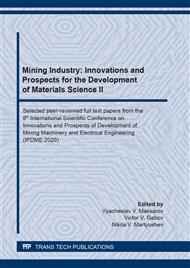[1]
S. Dmitriyev, A. Koudrin, V. Labunets, M. Kindrachuk, Functional coatings application for strengthening and restoration of aviation products. Avia. 9(4) (2005) 39–45.
DOI: 10.3846/16487788.2005.9635917
Google Scholar
[2]
T.S.N. Sankara Narayanan, K. Ravichandran, I.S. Park, Deposition of zinc-zinc phosphate composite coatings on steel by cathodic electrochemical treatment, J. Coat. Tech. Res. 11(3) (2013) 431–442.
DOI: 10.1007/s11998-013-9533-z
Google Scholar
[3]
K. Genel, Boriding kinetics of H13 steel, Vacuum. 80 (2006) 451–457.
DOI: 10.1016/j.vacuum.2005.07.013
Google Scholar
[4]
N. López-Perrusquia, J. Martínez-Trinidad, R. Escobar-Galindo, Characterization of AISI 4140 borided steels, Appl. Surf. Sci. 256 (2009) 2372–2379.
DOI: 10.1016/j.apsusc.2009.10.070
Google Scholar
[5]
Y. Kayali, Investigation of diffusion kinetics of borided AISI P20 steel in micro-wave furnace, Vacuum. 121 (2015) 129–134.
DOI: 10.1016/j.vacuum.2015.08.006
Google Scholar
[6]
S. Sahin, C. Meric, Investigation of the effect of boronizing on cast irons, Mater. Res. Bull. 37 (2002) 971–979.
DOI: 10.1016/s0025-5408(02)00697-9
Google Scholar
[7]
S. Taktak, Tribological behavior of borided bearing steels at elevated temperatures, Surf. Coatings Technol. 201 (2006) 2230–2239.
DOI: 10.1016/j.surfcoat.2006.03.032
Google Scholar
[8]
T. Balusamy, T.S.N. Sankara Narayanan, K. Ravichandran, Effect of surface mechanical attrition treatment (SMAT) on pack boronizing of AISI 304 stainless steel, Surf. Coatings. Technol. 232 (2013) 60–67.
DOI: 10.1016/j.surfcoat.2013.04.053
Google Scholar
[9]
H. Cimenoglu, E. Atar, High temperature tribological behaviour of borided surfaces based on the phase structure of the boride layer, Wear. 309 (2014) 152–158.
DOI: 10.1016/j.wear.2013.10.012
Google Scholar
[10]
E. Garcia-Bustos, M.A. Figueroa-Guadarrama, G.A. Rodríguez-Castro, O.A. Gómez-Vargas, The wear resistance of boride layers measured by the four-ball test, Surf. Coatings Technol. 215 (2013) 241–246.
DOI: 10.1016/j.surfcoat.2012.08.090
Google Scholar
[11]
M.S. Gök, Y. Küçük, A. Erdoğan, M. Öge, Dry sliding wear behavior of borided hot-work tool steel at elevated temperatures, Surf. Coatings Technol. 328 (2017) 54–62.
DOI: 10.1016/j.surfcoat.2017.08.008
Google Scholar
[12]
A. Yazici, U. Çavdar, A Study of Soil Tillage Tools from Boronized Sintered Iron, Met. Sci. Heat Treat. 58 (2017) 753–757.
DOI: 10.1007/s11041-017-0091-3
Google Scholar
[13]
U. Çavdar, B.S. Ünlü, A.M. Pinar, Mechanical properties of heat treated iron based compacts, Mater. Des. 65 (2015) 312–317.
DOI: 10.1016/j.matdes.2014.09.015
Google Scholar
[14]
F.L. Serafini, M.I. Peruzzo, Microstructure and mechanical behavior of 316L liquid phase sintered stainless steel with boron addition, Mater. Charact. 152 (2019) 253–264.
DOI: 10.1016/j.matchar.2019.04.009
Google Scholar
[15]
E. Franco, C.E. da Costa, J.C.G. Milan, E. Gordo, Multi-component boron and niobium coating on M2 high speed steel processed by powder metallurgy, Surf. Coatings Technol. 384 (2020) 125306.
DOI: 10.1016/j.surfcoat.2019.125306
Google Scholar
[16]
S.S. Yilmaz, R. Varol, The effect of surface hardening treatments on the mechanical properties of iron based P/M specimens, Powder Technol. 204 (2010) 236–240.
DOI: 10.1016/j.powtec.2010.08.007
Google Scholar
[17]
J.C.G. Milan, H.L. Costa, A.P. Krelling, Sliding wear of borided sintered AISI M2 steel coated with AlTiN/CrN multilayer, Wear 410–411 (2018) 11–24.
DOI: 10.1016/j.wear.2018.05.025
Google Scholar
[18]
M.W. Wu, W.Z. Cai, Phase identification in boron-containing powder metallurgy steel using EBSD in combination with EPMA, Mater. Charact. 113 (2016) 90–97.
DOI: 10.1016/j.matchar.2016.01.016
Google Scholar
[19]
H. Yang, X. Wu, G. Cao, Enhanced boronizing kinetics and high temperature wear resistance of H13 steel with boriding treatment assisted by air blast shot peening, Surf. Coatings Technol. 307 (2016) 506–516.
DOI: 10.1016/j.surfcoat.2016.09.029
Google Scholar
[20]
A. Erdoğan, Investigation of High Temperature Dry Sliding Behavior of Borided H13 Hot Work Tool Steel with Nanoboron Powder, Surf. Coatings Technol. 357 (2019) 886–895.
DOI: 10.1016/j.surfcoat.2018.10.066
Google Scholar
[21]
S. Dmitriev, V. Malikov, A. Ishkov, Investigation of thermal fields at phase boundaries in powder mixtures that are subject to melting and chemical transformation, Mater. Sci. For. 992 (2020) 1011–1015.
DOI: 10.4028/www.scientific.net/msf.992.1011
Google Scholar
[22]
V. Malikov, A. Ishkov, Chemical reactions at high-speed HFC-boriding, Jour. Phys. Conf. Ser. 1399(4) (2019) 044116.
DOI: 10.1088/1742-6596/1399/4/044116
Google Scholar


